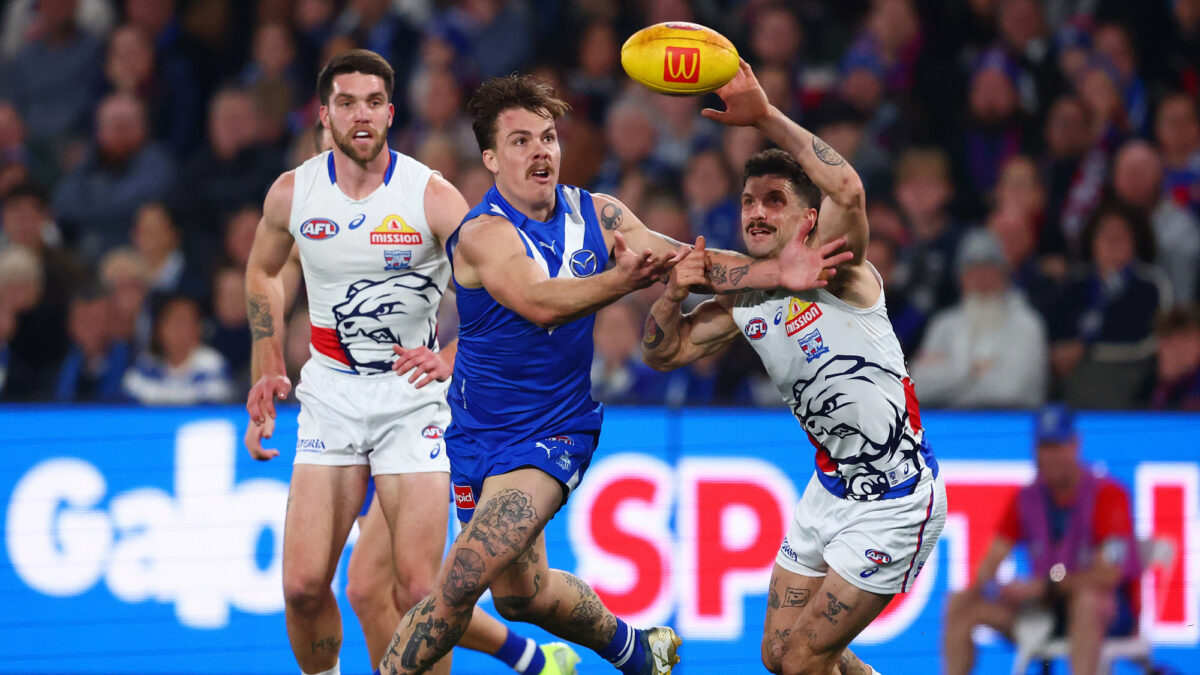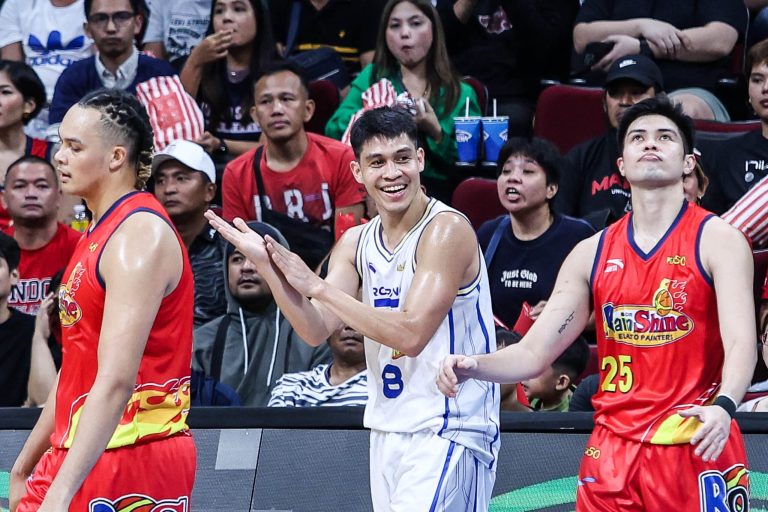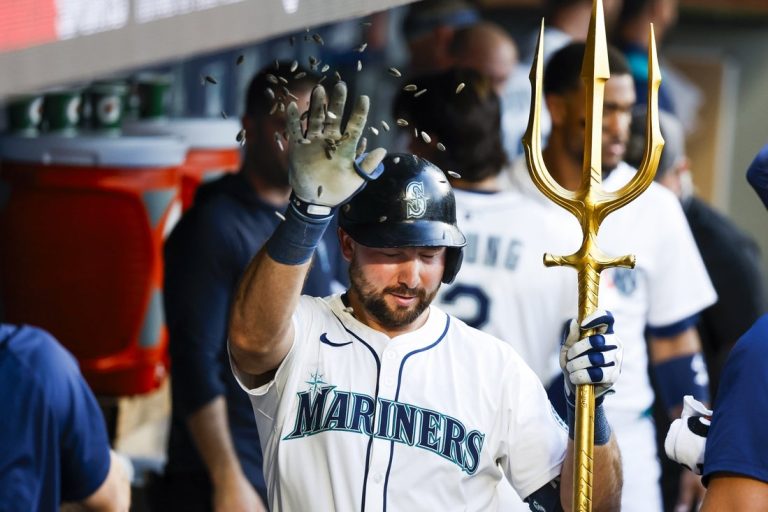Is it possible to have an unconvincing 49-point win?
The Western Bulldogs are in a situation where they can beat exactly one-half of the AFL competition for talent alone.
Thus was the case once again on Thursday night against North Melbourne, as it was against Richmond a fortnight ago, St Kilda twice this season, and Essendon, Port Adelaide and the Kangaroos again earlier in the season.
The Roos fought tooth and nail to mark their 100th anniversary celebration with an upset win, doing all the things you want bad sides to do: their tacking and pressure was exemplary, particularly in the first half, they aimed to move the ball quickly, took risks through the corridor, and looked to surge forward in a wave to put the Dogs’ defence under substantial pressure whenever they got past the halfway mark.
Midway through the third quarter, it looked like that could be enough, as they trailed by less than a goal with substantial momentum – but eventually, the absence of so much experience on the casualty ward, compounded further by losing Luke Davies-Uniacke to a concussion in the early minutes, proved too much to overcome.
When the stoppage battle North had been comprehensively winning for much of the first half evened up as the Dogs’ start-studded on-ball brigade took control, the favourites’ territory domination against a frail Roos backline – the sole exception Wil Dawson, whose height, reach and occasional defensive dark art kept Sam Darcy to miminal output up to three-quarter time – saw another hefty score piled on.
It made their frequent kicking blunders – the Dogs’ score from turnovers on Thursday night was their highest since 2002 – stand out all the more; the Bulldogs were always given chances to pile on goals, while North’s biggest avenue to the big sticks was more or less neutered. Eight goals in a quarter and 24 minutes was followed by five goals for the rest of the match, and just one in the last quarter.
All the same, this was a win that did absolutely nothing to put to ease the doubts over the Dogs’ bona fides this year, no matter their monster percentage, no matter their spot, at the time of writing, in the top four (though that’s likely to change by rounds end). If anything, in fact, concerns now are even greater than what they were before Thursday night.
For an undermanned North team to record their equal-highest score since Round 7, is a major worry; to do it from just 43 inside 50s is even more so. And it’s far from the first time the Dogs have proved exceptionally leaky without ball in hand.
This year, the Bulldogs are 13th for opposition scores per inside 50 against – St Kilda, North, Richmond, West Coast and Melbourne fare worse. That figure sits at just under 47 per cent, of which the Kangas were bang on that average at Marvel Stadium: Collingwood, the defensive standard-bearers and premiership favourites of 2025, are down at 39.4 per cent.
The problem for Luke Beveridge is that it’s a classic case of the Paul Rudd Anchorman quote: 60 per cent of the time it works every time. The Dogs give up fewer inside 50s than anyone else on average, are second behind only Gold Coast for inside 50 differential, and third-placed Brisbane are more than two behind on that latter stat.
That’s misleading, though, because the Dogs are only 10-6 at actually winning that inside 50 count. It’s inflated because of having 65 more inside 50s in their two games against the Saints, and going +22 against North and +21 against Richmond a fortnight ago.
Only twice this year – against Fremantle in Round 4 and Geelong in Round 11 – have the Dogs lost a match with more inside 50s than their opposition, while their narrow win over Sydney last week was just their second win (the other against Carlton in Round 2) where they’ve lost the count. And against the Swans, outperforming their expected score by 24 – in short, kicking goals out their proverbial – was the major reason why.
In short, the Dogs’ defence is in disarray. The confusion, though, is that it’s not actually the defenders at fault for most of it.
The Roos, tactically, brought the fight to the Dogs in the way good teams – and particularly Brisbane, Geelong and Gold Coast this season – have successfully implemented for high-scoring wins.
Whether from clearance or looking to move the ball from defence, their plan was to move the ball quickly, get the footy out the back going inside 50, and in the proces go over the top of a Dogs’ defensive structure that presses higher than just about anyone else.
Nearly all the scoring was done by Nick Larkey, and to be unkind to him, the main reason for it was that he was consistently the Roos’ deepest forward, naturally, and that the excellent work of his teammates up the field left defending him as an all but impossible task.
Larkey had five goals by the early minutes of the second quarter – three of those were running into an open goal after quick entries in saw him sneak out the back, while the other two were taking advantage of one-on-ones against lesser opponents near goal, James O’Donnell in the first instance and Nick Coffield in the second.
It’s the above play that really epitomises the Dogs’ defensive frailty – it’s Rory Lobb who gets the goal put against his name, but defending the entire 50m arc against Larkey, who is rushing back to goal at full tilt, he has no hope once the kick from Paul Curtis proves long enough to get away from his attempt to spoil.
The issue, really, is that the clearing kick from Dawson somehow finds North with a two on one in the central corridor. For any serious structure, that long, hacked kick from defence to get it out of trouble is either intercepted, or at least spoiled to ground to an outnumber to win the footy back.
All Harry Sheezel has to do in this instance is prevent Bailey Dale from marking, and Jacob Konstanty at ground level can mop up and continue moving the ball forward.
An ultra-aggressive structure like this makes even less sense considering the Dogs’ personnel are faulty – especially in the first quarter and a half, before Beveridge moved Bailey Williams from a wing into defence to successfully shore up a backline leaking like a sieve.
Just in front of where Dawson’s kick lands, Taylor Duryea has allowed the younger, quicker Paul Curtis to drag him all the way up to half-forward, and the minute that kick goes over both their heads the Dogs veteran is in trouble. Curtis has a metre on him when it reaches the Dale-Sheezel-Konstanty contest, and things get even worse when Duryea lets him run free ahead of the ball in a futile attempt to stop the latter from handballing.
Nick Coffield is also an issue here – nominally the Dogs’ spare behind the ball, he has so little impact on this contest he might as well have been replaced by a house plant. Really, he needed to be helping Dale out to equalise numbers in that contest, not 10 metres off it, and he spends the rest of the play ineffectually jogging alongside it achieving nothing.
The worst part is his positioning – for some reason, he appeared to be running for the vacant wings when Dawson kicked it in the first place, only to then be backtracking when the ball went straight up the centre. You never see a Magpies defender making such a basic mistake.
His spot in this team is problematic, because he’s not a lockdown small defender, he’s not big enough to take on the monsters – a fact Larkey nicely proved in the second quarter – he’s not particularly quick, and he doesn’t read the play well. Swap him, for example, with Rory Lobb in this play, and it’s far less likely that ball gets out the back as easily as it did – but of course, Lobb was required to man Larkey in both this play and for much of the rest of the match.
No-man’s land is also an issue for Tim English in this play; starting on a wing, he finishes at half-forward, standing ineffectually as Curtis, some 20 metres ahead of him, kicks the ball well over his head to Larkey and Lobb. Again, the comparison with Collingwood is clear: Darcy Cameron would have been a good 30 metres further back, in a position to try and help Lobb out with Larkey, or at least deter Curtis from trying to kick long.

Cameron Zurhaar and Tom Liberatore compete for the ball. (Photo by Morgan Hancock/Getty Images)
Most of the above isn’t the fault of the defenders, as harsh as the criticism on Coffield is: it’s all to do with structure. The Dogs set up in this way because they were all out on the attack – at the very start of the play, there are just five Roos in their defensive 50, compared to nine Bulldogs.
This type of one-way running gives your defence little chance, because the second it goes over any of their heads, their Roos counterparts are goalside and off to the races.
This happened incredibly often in the first half on Thursday night – and the bigger issue for the Dogs was that the Roos would regularly give chances to turn the ball over that weren’t taken.
Take this errant inboard handball from Robert Hansen, for instance: against most teams, that would be the death knell for the attacking play, yet because the Dogs defenders have pressed so high up – look at James O’Donnell and Coffield dashing back towards goal from almost a parallel line to where the ball is – it means the first player to get the loose ball is Curtis, who has the time and space to dish inboard to Zurhaar, with the option of either kicking for goal himself or handing Larkey another Joe the Goose.
From centre bounces, too, the Dogs are like bees to a honeypot, dragged up the field by their North counterparts and leaving space galore out the back – a big reason why the Roos kicked four goals from the centre square on Thursday night.
All it took was a clean break, or even a good tackle from Will Phillips to disposess Marcus Bontempelli, and the Roos were kicking to a three on three inside 50, with space galore – space enough for Larkey to be able to run back to a poorly aimed spoil from Lobb and, again, cruise into an open goal.
At Collingwood, or Geelong, or even Adelaide, there’s always a spare back there – someone has elected not to follow their man up to the contest, and stayed behind to either create an aerial outnumber with a fist or a mark, or stay at ground level to handle the crumbs.
The Dogs don’t, because they love to create overlap run via dashing half-backs – Bailey Dale, Lachie Bramble, Joel Freijah and the like. The question of whether it’s worth the trade-off is a curly one.
The biggest issue for the Bulldogs is this: their next two games are against Adelaide and Brisbane, who sit fourth and third respectively for average inside 50s. That’s a bad pair of opponents for a team that is struggling mightily at defending teams going into attack.
The Crows are third – behind only the Dogs and Geelong – for goals per inside 50 this year, while they score from more than half their entires. And of course they do – they have Riley Thilthorpe, Darcy Fogarty and Taylor Walker as key forwards, Josh Rachele and Izak Rankine crumbing at their heels, and Jordan Dawson banging goals through from every which way.
As it stands, that match, under the Marvel Stadium roof next Saturday, looks set to be a serious shootout: and the Dogs should know better than anyone that when it comes to high-scoring affairs this year, more often than not they’ve been found to be two or three goals short.






